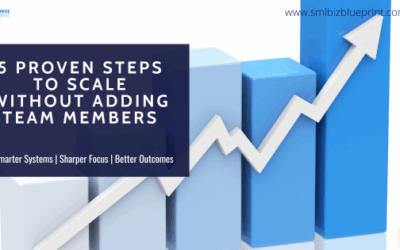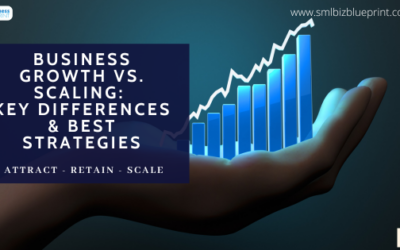Has your business growth come to a halt?
Many businesses experience a growth plateau at some point, during which revenue stagnates, customer acquisition slows, and new opportunities seem scarce.
Studies show that 70% of small businesses experience growth stalls after their first five years (U.S. Small Business Administration).
This plateau can feel frustrating, but it’s also an opportunity to reassess your strategies and make the changes necessary to reignite growth.
In this post, we’ll explore the top 5 reasons why your business growth has plateaued and provide actionable strategies for overcoming these challenges.
From optimising your marketing efforts and streamlining operations to leveraging new technologies like AI, we’ll guide you through proven techniques to help your business break through stagnation and return to success.
Read on if you’re ready to pinpoint the underlying causes of your stalled growth and discover how to accelerate your business again.

#1 What Are the Key Signs Your Business Growth Has Plateaued?
One of the most challenging aspects of a business growth plateau is recognising when it’s happening.
Growth stalls don’t always appear suddenly but rather gradually, making the warning signs easy to overlook.
Understanding the key indicators your business has plateaued can help you act early and prevent long-term stagnation.
Flat Revenue Growth
If your revenue has been stagnant for several months (or even years), it’s a strong indicator that your business has hit a growth ceiling.
Flat or declining revenue, despite consistent marketing and sales efforts, often signals that your current strategies are no longer effective in reaching new customers or expanding your market.
Decreased Customer Acquisition
Are you struggling to bring in new customers?
A sudden dip in customer acquisition or lead generation can be a red flag. When fewer new customers are coming through your sales funnel, it is essential to evaluate your marketing approach, messaging, and sales process.
It could be a sign that your target market has shifted or that your offering is not resonating as strongly as it used to.
High Customer Churn Rate
Losing existing customers at a higher-than-normal rate can also indicate a plateau in your growth. A high churn rate suggests that your business isn’t providing enough value or incentives for customers to stay, potentially pointing to issues with customer experience, product quality, or support.
Retaining your current customers is crucial for long-term growth, and a rising churn rate is a critical warning sign.
Stagnant Market Share
If your market share remains stagnant while competitors continue to grow, it’s a clear sign that your business growth has plateaued.
It may suggest that your business is not adapting quickly enough to market trends or failing to differentiate itself from competitors.
Tracking your market share relative to competitors can help you identify if your business is being outpaced.
According to a recent study, 60% of small businesses experience flat revenue growth within their first five years, primarily due to ineffective marketing strategies and customer retention issues (Forbes).
#2 Why Business Growth Stalls: Top 5 Causes to Watch For
Understanding the reasons behind a business growth plateau is crucial for taking corrective action. While every business is unique, common factors often lead to stagnant growth.
By identifying these causes, you can formulate strategies to help your business move past stagnation and return to a growth trajectory.
Market Saturation
Growth can come to a standstill when businesses fully penetrate their existing market. Market saturation can occur if your product or service has reached all potential customers within a specific region or niche.
This often happens when businesses have exhausted their core target audience and fail to expand into new markets.
To overcome this, consider diversifying your offerings or exploring untapped markets, both geographically and demographically.
Ineffective Marketing Strategies
Outdated or ineffective marketing strategies are a leading cause of growth stalls. If your marketing campaigns are not reaching the right audience, or if you’re not adapting to new digital marketing trends, your business can fail to attract new customers.
To maintain relevance and engagement, it’s essential to continuously evaluate your marketing efforts and stay up-to-date with current trends, such as AI-driven personalisation and social media strategies.
Operational Inefficiencies
Behind-the-scenes inefficiencies can quietly erode your business’s ability to scale.
Whether it’s outdated technology, poorly optimised workflows, or supply chain bottlenecks, operational inefficiencies can result in higher costs and slower delivery times, stunting growth. Implementing process improvements or investing in automation can streamline operations and help free up resources for future expansion.
Leadership Misalignment
A lack of alignment at the leadership level can create confusion and slow progress.
If the executive team is not unified in their vision or goals, it can cause friction within the business and result in missed opportunities. Leadership alignment is essential for making precise, decisive moves in the face of stagnation.
Regular strategy sessions and clear communication channels can ensure the leadership team is working towards the same growth objectives.
Lack of Innovation
Businesses that stop innovating risk becoming irrelevant. In today’s rapidly evolving market, customers expect continuous improvements, whether in product offerings, service delivery, or customer experience.
Failing to innovate can result in a loss of market share to competitors who introduce new and exciting solutions.
To avoid this, prioritise innovation by investing in research and development, seeking customer feedback, and encouraging a company culture of creativity and experimentation.
Research shows that 42% of companies fail due to a lack of market demand or ineffective marketing strategies, leading to stalled growth and eventual decline (CB Insights).
#3 Breaking Through Business Stagnation: Proven Strategies for Success
Once you’ve identified the reasons behind your business growth plateau, the next step is to take action. Breaking through stagnation requires a combination of strategic changes, operational improvements, and innovative thinking.
Here are some proven strategies to get your business back on a growth trajectory:
Reevaluate Marketing and Sales Strategies
Your marketing and sales strategies might need a refresh to attract new customers and retain existing ones. Start by conducting a comprehensive audit of your current campaigns to determine what’s working and what isn’t.
Consider adopting data-driven marketing techniques, such as targeted advertising, AI-powered personalisation, and retargeting, to reach your ideal audience more effectively.
Streamlining your sales funnel can help ensure that potential customers are smoothly guided from awareness to conversion.
Explore New Markets and Customer Segments
If your existing market has become fully saturated, it may be time to expand. Consider new geographical regions or underserved customer segments that could benefit from your products or services.
You could also explore adjacent markets where your offering may solve similar problems.
Expanding your market reach through digital channels, such as e-commerce, can unlock new revenue streams and allow your business to tap into previously inaccessible customer bases.
Improve Operational Efficiency
Breaking through a growth plateau often involves addressing inefficiencies holding your business back. Consider optimising your internal processes through automation, better project management tools, or leaner workflows.
This allows your team to focus on high-impact tasks that drive growth rather than being bogged down by operational bottlenecks. Streamlining operations reduces costs and frees up resources for investing in growth initiatives.
Focus on Leadership and Organizational Alignment
Business growth is a team effort, requiring leadership aligned with a common vision and set of goals.
If leadership misalignment is causing stagnation, it’s time to revisit your strategic objectives and ensure everyone at the executive level is on the same page.
Regular leadership meetings, clear communication, and goal-setting can ensure that your team works cohesively to advance growth initiatives.
Prioritise Innovation and Customer Experience
In today’s competitive market, innovation is critical to staying ahead. To break through stagnation, prioritise continuous product development, service improvements, and enhancements to the overall customer experience.
Listen to customer feedback and use it as a foundation for innovation.
Whether through new product launches, enhancements to existing offerings, or improved customer service, innovation is key to differentiating yourself from competitors and reigniting growth.
According to a McKinsey report, 80% of businesses that focus on innovation and customer experience see a marked improvement in revenue growth, proving that a customer-centric and innovative approach is vital for long-term success.

#4 How to Leverage Technology and Innovation to Accelerate Business Growth
In today’s fast-paced business environment, leveraging technology and innovation is no longer optional—it’s essential.
The rapid advancements in digital tools and AI allow businesses to streamline operations, better understand customer behaviour, and scale efficiently.
Here are key ways you can use technology and innovation to overcome a growth plateau:
AI-Powered Marketing Automation
AI has transformed how businesses approach marketing. By leveraging AI-driven marketing automation, businesses can better personalise their outreach, target specific customer segments, and optimise their campaigns in real-time.
Tools like AI-powered email marketing, chatbots, and predictive analytics allow businesses to deliver personalised experiences at scale, improving customer engagement and conversion rates.
This automation saves time, reduces human error, and ensures marketing efforts are more effective.
Data Analytics for Smarter Decision-Making
Data is one of the most valuable assets a business can leverage to drive growth.
Businesses can gain actionable insights into customer behaviour, market trends, and performance metrics using data analytics tools. These insights help refine strategies, optimise product offerings, and anticipate market shifts.
By making data-driven decisions, you can focus your resources on the areas most likely to generate growth.
For example, analytics can reveal which products or services have the highest demand, enabling you to prioritise those in your marketing and development efforts.
Automation for Operational Efficiency
Operational inefficiencies are a common barrier to growth.
Implementing automation tools in areas such as customer service, inventory management, and administrative tasks can help businesses reduce manual workloads and streamline their processes.
Automation allows teams to focus on strategic initiatives rather than getting bogged down by repetitive tasks. This improves productivity and leads to cost savings, both of which can be reinvested into growth initiatives.
Cloud Computing for Scalability
Cloud computing has revolutionised how businesses scale their operations. By leveraging cloud platforms, companies can access flexible and scalable IT resources on demand, reducing the need for costly infrastructure.
This allows companies to expand without significant upfront investment, making it easier to enter new markets, handle increased traffic, or offer new services.
Cloud solutions’ scalability ensures that your business can quickly adapt to growth opportunities without being held back by technical limitations.
Innovation in Customer Experience
Technology can also enhance the customer experience, a critical growth driver.
Businesses can provide faster, more personalised service by adopting tools like AI-powered chatbots, personalised recommendation engines, or virtual assistants. Improving the overall customer experience through innovation can increase customer loyalty, satisfaction, and, ultimately, repeat business.
Staying on the cutting edge of customer experience trends can also differentiate your brand from competitors and help you build a strong reputation in your market.
Research shows that businesses that adopt AI technology to streamline marketing and customer service processes experience a 10-20% increase in revenue growth within the first year (Harvard Business Review).
#5 Optimizing Operational Efficiency for Sustainable Business Growth
Operational efficiency is a cornerstone of sustainable business growth.
If your processes are inefficient or disorganised, your business may struggle to keep up with customer demand, maintain profitability, or scale effectively.
Optimising your operations ensures that resources are used wisely, costs are minimised, and growth can continue without unnecessary roadblocks.
Here are key ways to improve operational efficiency and support long-term growth:
Streamline Processes and Workflows
Streamlining your internal processes and workflows is one of the first steps to improving operational efficiency.
Review your business operations from end to end, identifying bottlenecks, redundant tasks, and areas for improvement. Implementing lean management techniques, such as eliminating waste and simplifying steps, can help your team work more efficiently and reduce delays.
Use workflow management tools to ensure tasks are properly assigned, monitored, and completed on time.
Implement Automation to Save Time
Automation is a powerful tool for improving efficiency. By automating routine tasks such as invoicing, inventory management, and customer communication, businesses can reduce employees’ time on manual, repetitive activities.
Automation also reduces the likelihood of human error, ensuring that processes run smoothly and consistently.
The time saved through automation can then be redirected towards more strategic tasks that drive growth, such as product development or customer acquisition.
Invest in Employee Training and Development
Your team is one of your greatest assets in terms of operational efficiency.
Regularly investing in employee training and development ensures your staff has the skills and knowledge to perform their jobs effectively and adapt to new technologies or processes.
Training employees on new tools, such as project management software or automation platforms, can help them work more productively.
Additionally, a well-trained team is more likely to independently identify and implement process improvements, contributing to ongoing efficiency gains.
Outsource Non-Core Functions
To optimise operations, consider outsourcing non-core functions not central to your business’s competitive advantage.
External providers can often more efficiently handle activities such as IT support, payroll management, and customer service.
Outsourcing these tasks allows your business to focus on core competencies that drive growth while benefiting from specialised service providers’ expertise and cost savings.
Use Data to Drive Continuous Improvement
Data-driven decision-making is vital to maintaining operational efficiency.
By tracking key performance indicators (KPIs) such as production times, customer satisfaction, and inventory turnover, businesses can identify inefficiencies and areas for improvement.
Regularly reviewing performance metrics allows you to make informed adjustments to processes, ensuring that your operations run smoothly as your business grows.
Business intelligence software can help you collect, analyse, and act on operational data in real-time.
According to a study by Deloitte, companies that focus on operational efficiency experience 30% faster revenue growth, as streamlined operations enable them to scale more effectively and reinvest in growth opportunities.
#6 How to Improve Customer Retention to Fuel Long-Term Growth
Customer retention is essential for sustainable business growth.
While acquiring new customers is important, retaining existing ones is often more cost-effective and can significantly impact your bottom line.
Increasing customer retention by just 5% can boost profits by 25% to 95% (Harvard Business Review).
Here are key strategies to enhance customer retention and drive long-term growth:
Build a Strong Customer Loyalty Program
A well-structured loyalty program is a powerful tool for keeping customers engaged and encouraging repeat purchases.
Offering incentives such as discounts, points, or exclusive rewards can increase customer loyalty and boost retention. Ensure the rewards are meaningful and attainable to create a compelling reason for customers to return.
Personalising loyalty offers based on customer behaviour can also enhance the program’s effectiveness.
Personalise the Customer Experience
Customers expect personalised interactions at every touchpoint.
Tailoring your communications, product recommendations, and offers based on customer preferences and past behaviours can significantly improve the customer experience.
Use customer data and AI-powered tools to create highly personalised marketing campaigns that resonate with your audience.
Personalisation shows customers that you understand their needs, strengthening their connection to your brand and increasing the likelihood of repeat business.
Offer Exceptional Customer Support
Providing high-quality, responsive customer service is one of the most effective ways to retain customers.
Your customer service team should be readily available to address any concerns or questions, whether through live chat, email, or phone support. Quick, effective resolutions to issues can turn a negative experience into a positive one, increasing customer loyalty.
Consider using AI-powered chatbots for 24/7 support, allowing customers to get help anytime.
Implement a Proactive Customer Feedback Loop
Actively seeking feedback from your customers helps you identify areas for improvement and shows that you value their input.
Conduct regular surveys, reviews, and feedback sessions to understand how customers perceive your products and services. Use this data to continuously improve the overall customer experience.
Additionally, responding to customer feedback quickly and thoughtfully demonstrates that you care about their satisfaction, which can greatly improve retention rates.
Focus on Post-Purchase Engagement
Customer retention doesn’t end at the point of sale.
Engaging with customers after a purchase is critical for building long-term relationships.
Follow up with personalised thank-you emails, requests for feedback, or product usage tips to maintain communication.
Consider offering exclusive promotions or cross-selling related products to encourage future purchases. The more value you provide post-purchase, the more likely customers will return.
Research shows that 65% of a company’s business comes from existing customers, highlighting the importance of focusing on customer retention to fuel long-term growth (Invesp).
Conclusion
Experiencing a business growth plateau can be challenging but also an opportunity to reassess and refocus your efforts.
By understanding the critical signs of stagnation and addressing the underlying causes—refining your marketing strategies, optimising operational efficiency, or leveraging technology—you can set your business back on a sustainable growth path.
Here’s a quick recap of the strategies covered:
- Recognise the early signs of a growth plateau, such as flat revenue and declining customer acquisition.
- Identify the top five causes of stagnation, from market saturation to a lack of innovation.
- Take action by reevaluating your marketing and sales strategies, exploring new markets, and improving operational efficiency.
- Leverage cutting-edge technology and innovation to streamline operations, improve customer experiences, and make data-driven decisions.
- Focus on optimising internal processes and workflows, automating tasks, and investing in employee development to create a scalable, efficient business.
- Finally, to fuel long-term growth, prioritise customer retention through loyalty programs, personalized experiences, and exceptional customer service.
Breaking through a business growth plateau isn’t easy, but it’s entirely possible with a strategic approach and a willingness to innovate.
Don’t wait for stagnation to damage your business—take proactive steps to reignite growth today.
Ready to take your business to the next level? Start by evaluating where your growth has plateaued and implementing these proven strategies.
Whether optimising your operations, leveraging AI, or improving customer retention, you have the tools to push past stagnation and accelerate growth.
FAQs
Q1: How can I tell if my business growth has plateaued?
A1: If your business is experiencing flat or declining revenue despite consistent marketing and sales efforts, struggling to acquire new customers, seeing higher customer churn, or maintaining stagnant market share, you’ve likely hit a growth plateau. Regularly reviewing your business performance metrics can help you identify these signs early.
Q2: What are the main reasons businesses experience growth stagnation?
A2: The most common reasons for growth plateaus include market saturation, ineffective marketing strategies, operational inefficiencies, leadership misalignment, and a lack of innovation. Addressing these factors can help reignite business growth.
Q3: How can I break through a growth plateau?
A3: To break through a growth plateau, reevaluate your marketing and sales strategies, explore new customer segments or markets, optimise operational efficiency, invest in technology like AI and automation, and ensure your leadership team is aligned on strategic goals. Focusing on innovation and improving the customer experience can also drive renewed growth.
Q4: What role does technology play in overcoming business stagnation?
A4: Technology, especially AI and automation, plays a crucial role in breaking through business stagnation by streamlining operations, personalising marketing efforts, and enabling data-driven decision-making. Tools such as marketing automation, data analytics, and AI-powered customer support can help businesses operate more efficiently and engage customers more effectively.
Q5: Why is customer retention necessary for growth, and how can I improve it?
A5: Customer retention is vital because acquiring new customers is far more expensive than keeping existing ones. Retained customers are also more likely to make repeat purchases, increasing long-term revenue. To improve customer retention, implement loyalty programs, personalise customer interactions, offer exceptional support, and engage customers post-purchase with tailored offers and communications.
Q6: How can I optimise my operations to sustain long-term growth?
A6: Optimizing operations involves streamlining workflows, implementing automation, outsourcing non-core functions, and using data to drive continuous improvement. These strategies help reduce inefficiencies, lower costs, and free up resources that can be reinvested in growth initiatives.
Q7: What steps should I take to expand into new markets or customer segments?
A7: To expand into new markets, conduct thorough market research to identify viable opportunities. Tailor your marketing and product offerings to fit the needs of these new markets, and consider leveraging digital channels, such as e-commerce or social media, to reach previously untapped customer bases. Expanding geographically or exploring adjacent market segments can also open new growth avenues.
Other Articles
How to Safeguard Your Business During Economic Downturns – 5 Proven Tactics
How Smart Companies Stand Out: 5 Proven Differentiation Strategies
How to Build a Customer Loyalty Program That Keeps Clients Coming Back




